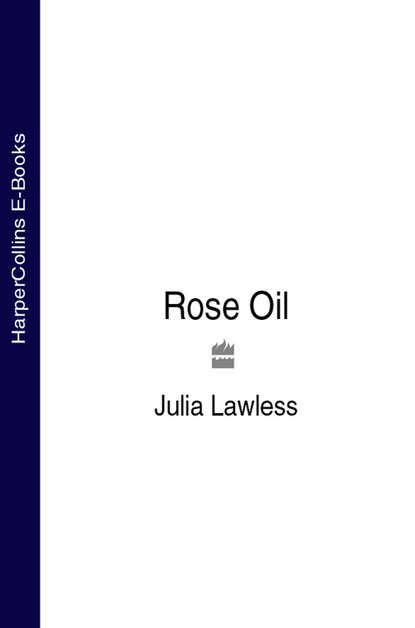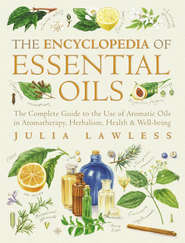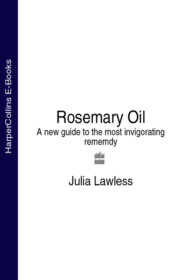По всем вопросам обращайтесь на: info@litportal.ru
(©) 2003-2024.
✖
Rose Oil
Настройки чтения
Размер шрифта
Высота строк
Поля
In the dry desert air, the wreath’s petals had shrivelled, but they still kept their colour, and when placed in warm water, the blossoms seemed to come back to life. Buds swelled, and the pink petals spread, unfolding to reveal the knot of golden threads at the centre just as they must have been on the morning of the funeral. A botanist at Cambridge had little trouble in identifying Petrie’s flowers as roses, specimens of ‘Rosa richardii’ (R. sancta), a species already known as ‘the Holy Rose of Abyssinia’ because at that time it was still a fixture of the Coptic Christian churchyards in that country.
Similar remains have also been found in graves throughout Middle Egypt, together with frescoes and scraps of fabric portraying simple roses with five petals. It is significant that the rose was one of the flowers sacred to the Egyptian Goddess Isis, guardian of love and destiny, who has been worshipped for more than 5,000 years! Signs of an ancient rose cult have also been found in India and in Syria – even the name Syria comes from the word ‘suri’, meaning ‘land of roses’. The ‘Holy Rose’ still grows in Egypt today, and can also be found in remote areas of Northern Ethiopia (the former Abyssinia). In 1920, a monk reported finding a rose growing in an Ethiopian mountain village at an altitude of 8,000 feet!
Trade in roses also became established at a very early stage in history. The royal groves of Ur in the Euphrates–Tigris region have revealed that the Sumerian King Sargon (2648–2630 BC) returned from a campaign bringing ‘vines, figs and roses’. Caravans wandered from the rivers of Babylonia, taking their cargo with them right across Egypt to North Africa. Arab nomads played a vital role in the distribution of the rose not only throughout the Middle East, but also later by bringing it to Europe.
Botanically speaking, however, it is difficult to locate the exact origin of the first wild rose because the early records are far from complete. What is clear is that from very early times there existed several distinct species of rose which were distributed throughout the northern hemisphere, having two main centres – one in Central Asia and the other in Western Europe. These became known as the ‘Old’ rose varieties because they formed the basis of all the subsequent hybrids, or ‘New’ roses.
The historical division between ‘Old’ and ‘New’ roses is generally taken to be the year 1800, due to the influence of France’s Empress Josephine. From 1808 and 1814 the Empress, wife of Napoleon Bonaparte, established a rose garden at Malmaison (outside Paris) which was unsurpassed. She obtained all the known roses of the time, including the newly arrived Asiatic and Chinese varieties. Their cultivation and propagation became an inspiration to rose-growers throughout the world, and formed the basis for the subsequent hybridization of the innumerable rose varieties.
Since then, roses have been bred as carefully as racehorses, and many new varieties have been developed. Today there are numerous books available on the cultivation of garden roses containing hundreds of lavish, glossy plates illustrating the diversity, beauty and allure of the modern (and often scentless) ‘New’ rose.
In recent years, however, there has a been a nostalgic return to the appeal of the ‘Old’ scented rose varieties. Their fragrance, which had often suffered in the pursuit of the perfect form, has also begun to be reevaluated. The most significant of these original and highly scented ‘Old’ roses, particularly regarding their subsequent cultivation and (highly successful) hybridization for the production of essential oils, are the following:
Rosa gallica (R. rubra) – the ‘Gallic Rose’
Rosa damascena – the ‘Damask Rose’
Rosa centifolia – the ‘Cabbage Rose’
The Gallic Rose
The natural habitat of the Gallic Rose is thought to have been Iran (formerly Persia) and the land between the Black and the Caspian Seas – though its real roots are lost in antiquity. Like the ‘Holy Rose’, the Gallic Rose originally blossomed in its natural wild state as a simple flower with five petals – mostly of a deep pink or ‘rosy’-red colour. Later, how-ever, R. gallica also came to exist in a whole range of different forms or sub-species, the best known being R. gallica var. officinalis – the ‘Apothecary Rose’ or the ‘Red Rose’, a shrub of 90 cm to 1.5 m (3 to 5 ft) high with very fragrant, semi-double deep crimson flowers and yellow anthers (centre). In early times, the petals of this variety were often made into a fragrant powder valued for its pharmaceutical properties. After the Middle Ages it also became known as the ‘French Rose’ or the ‘Rose of Provins’ because it was grown in high quantities in the French region of Provence, mainly for use in perfumery. Varieties of the Gallic Rose are still used for the production of essential oils, for example by the British pioneer microbiologist, Peter Wilde.
The Damask Rose
The Damask Rose (Rosa damascena) – so called because it was presumed to have been brought originally from Damascus in Syria – bears pink or red, very fragrant double flowers with up to 36 petals each, borne on arching stems reaching to 2 m (7 ft) long. This was the rose most used by the early Arab perfume makers, who introduced it to Europe. It is still used to produce a very high quality essential oil, ‘attar of rose’ (and absolute), mainly for use in perfumery. Today it is cultivated on a large scale in Bulgaria and Turkey, and to a lesser extent in Russia, India and Iran. It too has been recorded in many different forms or sub-species, notably the 30-petalled variety, ‘Trigintipetala’.
The Cabbage Rose
The Cabbage Rose or ‘Hundred-leaved Rose’ is not, strictly speaking, an ‘Old’ rose despite its long history, being a complex hybrid between the Gallic Rose, the Damask Rose, the wild ‘Dog Rose’, and the ‘Musk Rose’ (see below). Its origins are obscure, though it has been found growing wild in the forests of the Caucasus, where double-flowered specimens are common. It has been called the ‘Painter’s Rose’ because it appears in the artwork of so many of the Old Masters. It is a handsome, bushy shrub, generally 90 cm to 1.5 m (3 to 5 ft) high, bearing large blooms with up to 100 petals each, which can be white through to dark red. It produces a rich, sweet-scented oil or absolute for which it is widely cultivated in Turkey and North Africa (Morocco and Tunis). For centuries a type of Cabbage Rose has been grown in the region of Grasse in France and known as the ‘Rose de Mai’ – a hybrid between R. centifolia and R. gallica. This variety can grow to a height of 2 m (7 ft) and has pink to rose-purple flowers. The Cabbage Rose has subsequently given rise to innumerable sub-species, including the ‘Moss Rose’.
Other ancient varieties which are still used for the production of essential oils, but on a smaller scale, include the ‘Dog Rose’ (Rosa canina), ‘Sweet Briar’ (R. rubiginosa), the ‘Musk Rose’ (R. moscatta), the ‘Tea Rose’ (R. indica), the ‘White Rose’ (Rosaxalba), and the ‘Japanese (or Chinese) Rose’ (R. rugosa).
Note: See Appendix A (#litres_trial_promo) for a more detailed description of these rose species.
PART 1 (#ulink_89c6ffe7-5473-5b89-a395-85bfa17ac174)
A Medical and Historical Background (#ulink_89c6ffe7-5473-5b89-a395-85bfa17ac174)
CHAPTER ONE (#ulink_7d0b20ff-41b5-55c8-b7fd-7346e70f1c69)
Legend, Myth and Symbolism (#ulink_7d0b20ff-41b5-55c8-b7fd-7346e70f1c69)
Red rose, proud rose, and rose of all my days
Come near me while I sing thy ancient ways…
W. B. Yeats ‘The Rose upon the Rood of Time’
For thousands of years the rose has been prized by all cultures alike – indeed, throughout the ages no flower has enjoyed such favour! Classical texts from both East and West contain numerous references to the rose, and a whole range of myths has sprung up and flourished regarding its origins and symbolism. The symbolism of the rose is perhaps one of the richest and most complex associated with any plant, with a universal appeal that transcends time and cultures. As a powerful image of the heart or soul of humanity, the rose has always represented ‘love’, ‘beauty’ and ‘divinity’ along with many other attributes.
‘By thy scent my soul is ravished…’ wrote the poet Sadi. He, like many other great Persian writers, saw the rose not only as an object of great physical beauty but also as a symbol of spiritual attainment and transcendent desire. In the Avesta, the sacred book of Persia which forms the basis of one of the world’s oldest religions, the rose is honoured as ‘a messenger of the garden of souls’. Rumi (the great thirteenth-century Sufi mystic and poet) called the rose a ‘wise loveliness’, and a manifestation of the experience of the eternal ‘Beloved’:
Like a rose, I smile with all my body, not only with my mouth,
For I am – without myself – alone with the King of the World
Rumi, Divan-e-Kabir
Among the Sufis, the experience of the sacred was intimately associated with the form and scent of the rose, and the Persian alchemist and mystic Avicenna dedicated a whole book to the virtues of his favoured plant. According to one Persian legend, the nightingale fell in love with the white rose and flew down to embrace it. But she pierced her breast upon its sharp thorns, and from the drops of blood falling on the earth there grew the first deep crimson rose:
… And above all, the repeated splendours of glowing dawns, the profusion of rose gardens, white roses and red roses, the shades of the rose bushes, the divine presence flashing in the brilliance of a red rose.
Ancient Persia is thought to be the birthplace of the cultivated rose, and the first place where roses were planted in beautifully laid out gardens. When the Moslem Arabs conquered Persia in the sixth century, they were so enamoured with the cultivated roses which they found growing there that Islam adopted the rose as central to its own tradition. Indeed, according to Arabic legend, when the prophet Muhammad was taken to heaven a drop of his sweat fell to earth and this became the first rose! In another story, roses come not from the prophet but from the perspiration of a lady, Joun, whose skin is white at dawn but rosy at midday. Later, as the Moslem religion spread to large areas of the known world, the love of the rose went too.
As early as 900 BC, Homer described in the Iliad that the shield of Achilles was decorated with roses – as were the shields of the ancient Persian warriors. In addition, the custom which is still known today of strewing roses on the graves of the dead can be traced back to this period. In ancient Greece the rose was held sacred to Aphrodite, goddess of love and beauty. According to Greek legend, the first rose grew out of the white foam that covered Aphrodite at her birth. For the Greeks, the red rose is said to have issued from the blood of her beloved Adonis after he was attacked by a wild boar – the word ‘rosa’ derives from the Greek word ‘rodon’, meaning red:
… the crown jewel of the flowers, and the royal purple of wise men, the mirror of beauty. Full of love she is Aphrodite’s servant; with fragrant leaves shining brightly she sways above the foliage bathing in the smiles of Zephyr.
Achilles Tatios, 139 BC
As the cult of the rose spread over the whole of ancient Greece and beyond, so did the mythology surrounding it. One of the oldest Roman stories is of Flora, who upon finding the corpse of a beautiful nymph, a daughter of the Dryads, transformed her body into the first rose with the assistance of Venus and the Graces. Apollo then blessed the flower, Bacchus supplied the nectar, Vertumnus the perfume, while Pomona gave her fruit and Flora crowned her with beauty. According to another legend, the first rose was said to have originally been white in colour, the red varieties coming into being when a thorn pierced the foot of Venus – her blood staining the petals crimson.
Although the rose had been revered by many early civilizations, with the Romans worship of the rose took on unsurpassed proportions. Indeed, no other culture has been as obsessed with the rose in a literal sense, as that of ancient Rome … they even created a holiday, ‘Rosalia’, to consummate their passion for the flower!
Roses were strewn at public ceremonies and banquets; rosewater bubbled through the emperor’s fountains and the public baths surged with it; in the public amphitheaters, crowds sat under sun awnings steeped in rose perfume; rose petals were used as pillow stuffings; people wore garlands of roses in their hair; they ate rose pudding; their medicines, love potions, and aphrodisiacs all contained roses. No Bacchanalia, the Romans’ official orgy, was complete without an excess of roses… At one banquet, Nero … spent the equivalent of fifty thousand pounds just on roses – and one of his guests smothered to death under a shower of rose petals.
In 220 AD, Athenaeus mentions that rose petals were strewn eight inches deep upon the ground in Cleopatra’s private chambers when she first met Mark Antony! In the early years of the Roman Empire, the rose was linked with Venus, the Goddess of love – but in latter years, as the Empire declined and decayed, it came to stand for vice and immoral behaviour. After the fall of the Empire, the Roman Catholic Church thus condemned the rose as a heathen flower. The Church was particularly contemptuous of the old pagan custom of offering wreaths of roses to the dead:
If they are blessed, they do not need them – and if they are lost, they won’t have any pleasure in them!
But the rose was not an image that could be wiped clean from human consciousness. The custom of offering roses to the dead persisted, and since the symbolism of the rose could not be eradicated, it gradually became incorporated into early Christian mythology. The red rose became the symbol of Jesus’ blood – the five petals representing the five wounds of Christ – and a sign of martyrs and saints. The custom of decorating churches with roses and carving roses over the entrance to the confessional as an emblem of discretion also dates from Roman times. In the Roman story, the rose was given by Cupid as a bribe to Harpocrates, the god of Silence. Henceforth, a rose was suspended above Roman banqueting tables to indicate that anything said beneath it was to be held in strictest confidence – the origin of the expression ‘sub-rosa’.
To the early Christian mystics, the rose (especially the white rose) was also associated with the Virgin Mary and the ideal of ‘purity’ or ‘divine love’. The Madonna is often depicted in a garden of roses in icon paintings. Here, the rose indicates Mary’s love for the child Jesus, while more profoundly it suggests the love required for the nurturing of the Christ principle within. According to tradition, the Virgin appeared to St Dominic bearing a chaplet of roses, and the first rosary was made in commemoration of this vision. Rosaries originally consisted of 165 dried, carefully rolled up rose petals, sometimes darkened with lampblack as a preservative. One of the oldest Maria hymns says:
Fresh rose, pure rose, chaste rose,
Without thorns, rose flowering,
Fruits bearing, burning red,
More than a rose, whiter than a lily.
During the following centuries, roses became more and more widespread as the Crusaders returned to Europe bringing with them new and old varieties. In the days of chivalry, a chaplet of roses was granted to gallant knights for acts of bravery, and the image of the rose became associated with sovereignty. Different types of roses were increasingly used in royal heraldry, as in Britain’s ‘Wars of the Roses’, the thirteenth-century feud between the House of York (the white rose) and the House of Lancaster (the red rose). The Tudor rose of Elizabeth I bore the motto Rosa sine spina (‘a rose without a thorn’), and the wild dog rose (Rosa canina) remains the royal flower of England. The British King or Queen is still anointed at the coronation ceremony with a ‘holy oil’ containing rose essence, the recipe for which dates back to the twelfth century.
During the Middle Ages, the rose naturally became the favoured flower of the famous ‘troubadours’ and often featured in their love poetry:
Maiden may I go with thee to thy rose garden?











